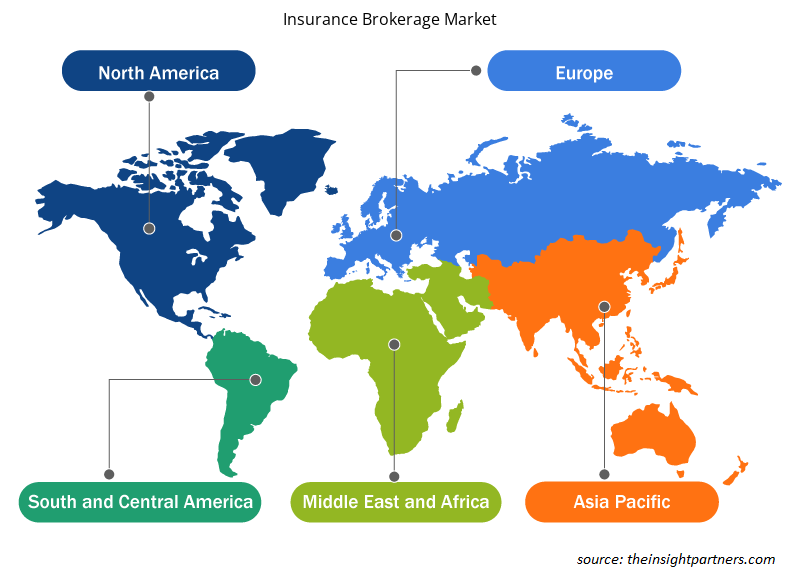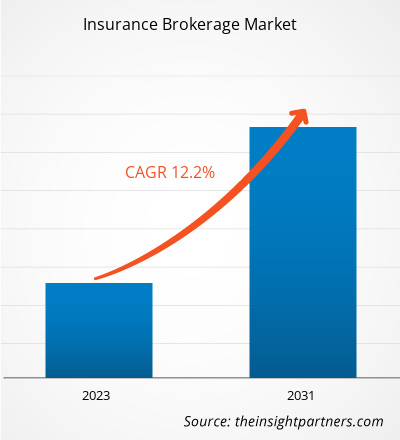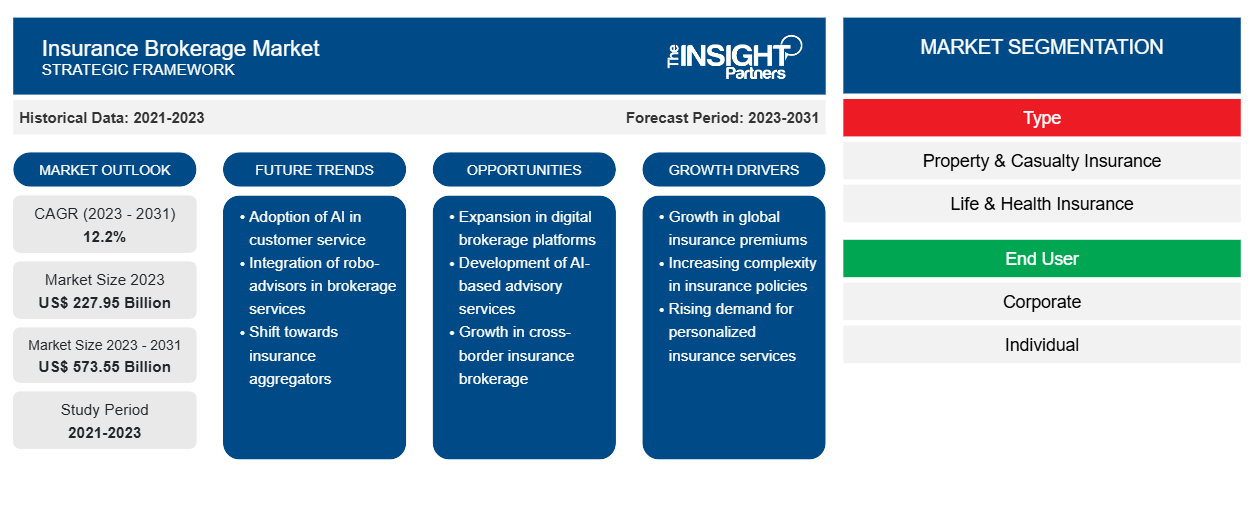保険仲介市場規模は、2023年の2,279.5億米ドルから2031年には5,735.5億米ドルに成長すると予想されており、2023年から2031年にかけて12.2%のCAGRで拡大すると予想されています。この市場には、現在の保険仲介市場の動向と予測期間中のその予測可能な影響により、成長の見通しが含まれています。この市場は、保険業界の大規模で拡大しているセクターです。保険仲介市場は、保険契約の需要の増加やデジタルブローカーの拡大などの要因により成長しています。さらに、政府の好ましい取り組みは、市場の成長に有利な機会を提供します。ただし、保険を購入するための代替オンラインプラットフォームが利用可能であることが、市場の成長を抑制しています。
保険仲介市場分析
再保険は保険会社にとって保険と呼ばれます。再保険は再保険会社と保険会社の間の契約です。再保険は保険会社が請求者に支払った金額の全部または一部を取り戻すことで事業継続に役立ちます。再保険は特定のリスクに対する純負債を減らし、重大な損失または多数の損失に対する災害保護を提供します。保険会社が再保険を購入する理由は 4 つあります。それは、キャパシティの増強、損失経験の安定化、災害から保険会社自身と被保険者を保護すること、および特定のリスクに対する責任を制限することです。再保険は累積負債から保険会社を保護することで、まれで重大なイベントが発生した場合に保険会社が財政的負担を負うキャパシティを高めます。これにより、保険会社は自己資本と支払能力をさらに確保できます。支払能力マージンを維持するために、保険会社は再保険を利用して管理費を不必要に増やすことなく、より多くのリスクをカバーする保険契約を引き受けることができます。さらに、再保険は保険会社に異常損失が発生した場合に多額の流動資産を提供します。
グローバル化は、国境を越えた商業および金融ネットワークの拡大の結果として、ここ数十年で進展し、他の経済圏の企業や労働者の相互接続がますます進んでいます。グローバル化が進むと、国際投資の機会が増え、投資に関連したプログラムが増えます。さらに、産業化によって投資の増加、より広範なコラボレーション、パートナーシップ、合弁事業も促進され、保険仲介市場の成長が促進されます。
要件に合わせてレポートをカスタマイズする
このレポートの一部、国レベルの分析、Excelデータパックなど、あらゆるレポートを無料でカスタマイズできます。また、スタートアップや大学向けのお得なオファーや割引もご利用いただけます。
- このレポートの主要な市場動向を入手してください。この無料サンプルには、市場動向から見積もりや予測に至るまでのデータ分析が含まれます。
再保険業界の概要
- デジタル技術が進化するにつれ、保険仲介業者はコストを削減し、プロセスを最適化し、顧客とつながるための新しい方法を継続的に模索しています。
- 保険ブローカーは、モバイルデバイスの使用を拡大しながら、人工知能(AI)、自動化、ビッグデータなどのテクノロジーへの投資を強化し続けています。
- さらに、モノのインターネット (IoT) は、ブローカーや保険会社に、顧客情報リポジトリを強化する効率的なリスク管理ツールとシステムを設計するための膨大な量のデータと洞察を提供し、それによって顧客のニーズに基づいてタイムリーで適切な補償を提供できるようになります。
- さらに、テクノロジーにより、より正確なパーソナライズされたサービスを提供できるようになります。
保険仲介市場の牽引役
保険契約の需要増加が保険仲介市場を牽引
- 保険業界は、世界中で最も急速に成長している分野の 1 つです。生命保険、健康保険、自動車保険などの保険商品は、業界全体で膨大な量を生み出しています。
- これらの保険商品の流通は、直接チャネルや仲介チャネルなど、さまざまなチャネルを通じて行われます。
- 仲介チャネルには、代理店、ブローカー、小売業者、バンカシュアランスなどが含まれます。したがって、保険商品の採用が増加すれば、保険仲介市場の成長も増加します。
- 保険ブローカーは、顧客の要望に基づいて保険契約に関する専門的なアドバイスを提供し、その見返りとして、保険契約が選択された保険会社から仲介手数料を受け取ります。
- さらに、大多数の顧客は時間とお金を節約するためにブローカーから保険を購入することを好みます。そのため、保険契約の需要の増加が保険仲介市場を牽引します。
保険仲介市場レポートのセグメンテーション分析
- 保険仲介市場は、種類別に生命保険・健康保険と損害保険に分類されます。損害保険セグメントは、2023年に保険仲介市場で大きなシェアを占めると予想されています。
- 自然災害の頻度と深刻度が高まり、財産保険の必要性が高まっているため、損害保険部門も予測期間中に最高の CAGR を維持すると予想されています。
- 消費者や企業は、洪水、ハリケーン、山火事などのさまざまな自然災害に対する保護を求める傾向が高まっており、これが市場におけるこのセグメントの成長を促進しています。
保険仲介市場シェア分析(地域別)
保険仲介市場の範囲は、主に北米、ヨーロッパ、アジア太平洋、中東およびアフリカ、南米の 5 つの地域に分かれています。北米は急速な成長を遂げており、保険仲介市場で大きなシェアを占めると予想されています。この地域の著しい経済発展、人口増加、リスク管理と保険契約への注目の高まりが、この地域の市場の成長に貢献しています。
保険仲介市場の地域別洞察
予測期間を通じて保険仲介市場に影響を与える地域的な傾向と要因は、Insight Partners のアナリストによって徹底的に説明されています。このセクションでは、北米、ヨーロッパ、アジア太平洋、中東、アフリカ、南米、中米にわたる保険仲介市場のセグメントと地理についても説明します。

- 保険仲介市場の地域別データを入手
保険仲介市場レポートの範囲
| レポート属性 | 詳細 |
|---|---|
| 2023年の市場規模 | 2,279.5億米ドル |
| 2031年までの市場規模 | 5,735億5,000万米ドル |
| 世界のCAGR(2023年~2031年) | 12.2% |
| 履歴データ | 2021-2023 |
| 予測期間 | 2023-2031 |
| 対象セグメント | タイプ別
|
| 対象地域と国 | 北米
|
| 市場リーダーと主要企業プロフィール |
|
保険仲介市場のプレーヤー密度:ビジネスダイナミクスへの影響を理解する
保険仲介市場は、消費者の嗜好の変化、技術の進歩、製品の利点に対する認識の高まりなどの要因により、エンドユーザーの需要が高まり、急速に成長しています。需要が高まるにつれて、企業は提供内容を拡大し、消費者のニーズを満たすために革新し、新たなトレンドを活用し、市場の成長をさらに促進しています。
市場プレーヤー密度とは、特定の市場または業界内で活動している企業または会社の分布を指します。これは、特定の市場スペースに、その規模または総市場価値と比較して、どれだけの競合相手 (市場プレーヤー) が存在するかを示します。
保険仲介市場で事業を展開している主要企業は次のとおりです。
- マーシュ・アンド・マクレナン・カンパニーズ
- エーオン
- ウィリス・タワーズワトソン
- ハブインターナショナルリミテッド
- アクリシュア LLC
免責事項:上記の企業は、特定の順序でランク付けされていません。

- 保険仲介市場のトップキープレーヤーの概要を入手
「保険仲介市場分析」調査は、タイプ、エンドユーザー、モード、および地理に基づいて実施されました。タイプに基づいて、市場は損害保険と生命保険と健康保険の再保険に分割されています。エンドユーザーに基づいて、市場は法人と個人に分割されています。モードに基づいて、市場はオンラインとオフラインに分割されています。地理に基づいて、市場は北米、ヨーロッパ、アジア太平洋、中東およびアフリカ、南米に分割されています。
保険仲介市場のニュースと最近の動向
企業は市場で合併や買収などの無機的および有機的な戦略を採用しています。最近の主要な市場動向をいくつか以下に示します。
- 2024年1月、米国を拠点とする独立系保険仲介業者ロックトンはインド市場への参入を発表しました。世界中に135以上のオフィスを持つロックトンのインド進出は規制当局の承認を条件としています。これにより、リスクコンサルティングおよび管理サービスに対するインドの高まる需要を満たすことができます。
[出典: ロックトン、企業ウェブサイト]
- 2023年11月、保険ブローカー会社RiskBirbalは、中小企業の財務リスクを軽減することを目的とした保険およびリスク管理製品の発売を発表しました。同社は、リスク管理戦略とともに人工知能とモノのインターネットベースのテクノロジーを使用して、財務リスクを軽減し、中小企業向けのソリューションを構築します。
[出典: RiskBirbal、企業ウェブサイト]
保険仲介市場レポートの対象範囲と成果物
保険仲介市場の予測は、主要な企業出版物、協会データ、データベースなど、さまざまな二次および一次調査結果に基づいて推定されています。市場レポート「保険仲介市場の規模と予測(2021〜2031年)」では、以下の分野をカバーする市場の詳細な分析を提供しています。
- 対象範囲に含まれるすべての主要市場セグメントについて、世界、地域、国レベルでの市場規模と予測。
- 推進要因、制約、主要な機会などの市場の動向。
- 今後の主な動向。
- 詳細なPESTおよびSWOT分析
- 主要な市場動向、主要プレーヤー、規制、最近の市場動向を網羅した世界および地域の市場分析。
- 市場集中、ヒートマップ分析、主要プレーヤー、最近の動向を網羅した業界の状況と競争分析。
- 詳細な企業プロフィール。
- 過去2年間の分析、基準年、CAGRによる予測(7年間)
- PEST分析とSWOT分析
- 市場規模価値/数量 - 世界、地域、国
- 業界と競争環境
- Excel データセット
最新レポート
関連レポート
お客様の声
購入理由
- 情報に基づいた意思決定
- 市場動向の理解
- 競合分析
- 顧客インサイト
- 市場予測
- リスク軽減
- 戦略計画
- 投資の正当性
- 新興市場の特定
- マーケティング戦略の強化
- 業務効率の向上
- 規制動向への対応























 無料サンプルを入手 - 保険仲介市場
無料サンプルを入手 - 保険仲介市場